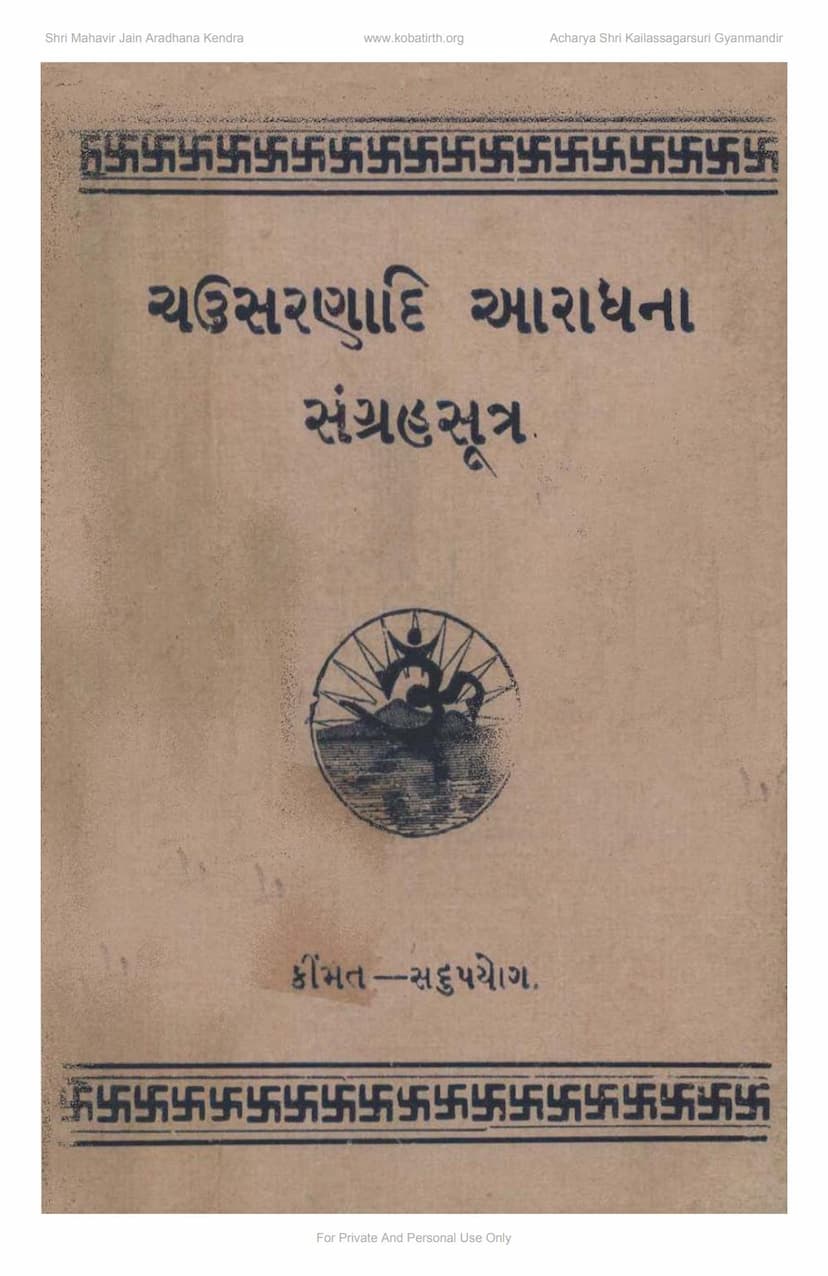Chausaranadi Aradhana Sangraha Sutra
Added to library: September 1, 2025

Summary
Here's a comprehensive summary of the Jain text "Chausaranadi Aradhana Sangraha Sutra" based on the provided pages:
Book Title: Chausaranadi Aradhana Sangraha Sutra Author(s): Saubhagyachand Khimchand Publisher: Saubhagyachand Khimchand
This book is a compilation of Jain devotional and penitential texts, primarily focusing on practices and prayers related to the "Four Refuges" (Chausaran) and other important spiritual disciplines. The text is presented in Gujarati with explanations and meanings.
Overall Purpose:
The "Chausaranadi Aradhana Sangraha Sutra" serves as a guide for Jain practitioners seeking spiritual purification, merit accumulation, and progress on the path to liberation. It emphasizes the importance of understanding and practicing key Jain tenets through specific prayers, recitations, and vows.
Key Sections and Their Content:
The book is structured to provide a comprehensive approach to spiritual practice, covering various aspects of Jain dharma. Based on the table of contents and the content presented, the main sections include:
-
Chausaranadi Aradhana Sutra (Four Refuges and other practices): This is the core of the compilation. It focuses on the significance of taking refuge in the Four Jewels of Jainism:
- Arihant: The enlightened beings who have conquered their passions and karmas.
- Siddha: The liberated souls who have attained omniscience and eternal bliss.
- Sadhu: The ascetic monks who follow the path of righteousness and detachment.
- Dharma: The teachings of the Tirthankaras, the path of righteousness and non-violence.
The text elaborates on the qualities of these refuges and provides prayers and verses (shlokas) to invoke their blessings and seek guidance. It explains how these refuges help overcome the cycle of birth and death (samsara). The verses emphasize devotion, surrender, and the transformative power of seeking refuge in these pure souls and principles.
-
Aurar Pacchakhan (Aura Pacchakhan): This section likely deals with the practice of Aura (likely referring to specific vows or observances) and Pacchakhan (vows or renunciations). It explains different types of vows, such as those taken by lay Jains (Shravaka/Shravika) like the five Anuvratas (minor vows) and seven Shiksha Vratas (disciplinary vows). The text details the nature of "Bal Pandita Maran" (a type of death where one dies with some residual attachments or without complete purification) and contrasts it with "Pandita Maran" (wise death), emphasizing the importance of proper preparation and renunciation. It includes a detailed list of faults and undesirable thoughts (meditations) that one should confess and renounce.
-
Pap Pratishthata ane Gunajee Adhan Sutra (Pap Pratishthata and Gunajee Adhan Sutra): This section focuses on the renunciation of sins (Pap) and the cultivation of virtues (Gun). It likely explains various types of sins and the karmic consequences they entail. The text then provides guidance on how to cultivate virtues and spiritual qualities, possibly through specific practices or reflections. The prayers in this section aim to purify the soul from negative tendencies and to foster positive spiritual attributes.
-
Chatur Gati Jiva Kshama-paani (Chatur Gati Jiva Kshama-paani): This part is dedicated to seeking forgiveness (kshama) from all beings in the four realms of existence (Narak - hellish beings, Tiryan - animals/transient beings, Manushya - humans, and Deva - celestial beings). It acknowledges the karmic actions and their consequences that have caused suffering to others across various lifetimes. The prayers express remorse and a sincere desire for reconciliation and purification from past transgressions against all forms of life.
-
Shri Atmabhavana (Shri Atmabhavana): This section is likely an exposition on the nature of the soul (Atma) and its journey. It may delve into the philosophical aspects of Jainism, focusing on the inherent purity of the soul and the means to realize its true nature. The text would guide the practitioner in self-reflection and meditation to understand the self, its eternal qualities, and its liberation.
-
Padmavati Aradhana: This section is dedicated to the worship and invocation of Goddess Padmavati, a prominent Yakshini (attendant deity) in Jainism, often associated with power, protection, and overcoming obstacles. The prayers and verses would likely focus on seeking her blessings for spiritual progress and worldly well-being.
-
Taradhana (Taradhana): While the specific meaning of "Taradhana" isn't immediately clear from the provided text, in a Jain context, it could refer to practices related to celestial beings, stars, or even specific spiritual practices associated with overcoming certain states or hurdles in the spiritual journey.
Key Themes and Principles:
- The Four Refuges (Chausaran): The central importance of seeking refuge in Arihants, Siddhas, Sadhus, and Dharma as the path to liberation.
- Renunciation and Vows (Pacchakhan): The practice of taking vows and renouncing worldly attachments and sinful activities is crucial for spiritual progress.
- Confession and Penance (Pratikraman): The necessity of confessing past wrongdoings and performing penance to purify the soul.
- Virtue Cultivation: The emphasis on developing positive qualities like compassion, non-violence, truthfulness, and detachment.
- Forgiveness: The importance of seeking forgiveness from all living beings for past harms caused, and extending forgiveness to others.
- Spiritual Wisdom: The pursuit of knowledge about the soul, karma, and the path to liberation, as taught by the Tirthankaras.
- Devotion and Surrender: The role of faith and surrender to the liberated souls and the Jain principles.
- The Cycle of Rebirth: An understanding of the endless cycle of birth and death (samsara) and the methods to escape it.
- The Importance of the Human Birth: Recognizing the rarity and significance of a human birth as a unique opportunity for spiritual practice.
Publishing Context:
The book is presented as being published by Saubhagyachand Khimchand, possibly as a devotional offering or for the propagation of Jain teachings. The publication dates are given as Veer Samvat 2460 and Samvat 1990, indicating its historical significance. The text also acknowledges the inspiration and guidance of Acharya Shri Kailassagarsuri and Guru Shri Ratnamuni.
In essence, the "Chausaranadi Aradhana Sangraha Sutra" is a valuable resource for Jains, offering a structured approach to spiritual practice, emphasizing devotion, penance, and the cultivation of virtues for the ultimate goal of liberation.